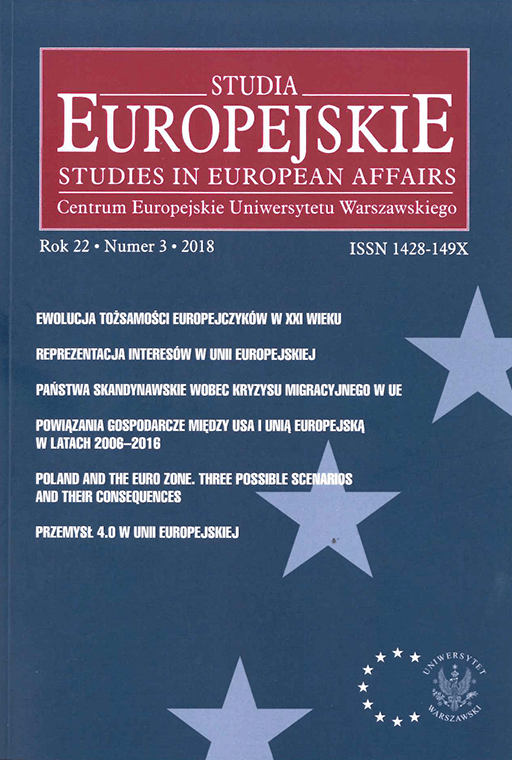
ISSUE: 3/2018
- Volume 22
- Number 3
- 2018
Subscribe NEWSLETTER
Studia Europejskie –
Studies in European Affairs
ISSN: 1428-149X
e-ISSN: 2719-3780
License
Articles published in the journal are under a Creative Commons Attribution – Non Commercial – No Derivatives 4.0 International License
Poland and the Euro Zone. Three Possible Scenarios and Their Consequences
Abstract
The Euro zone has undergone profound institutional changes since the occurrence of its 2010 crisis. The EU countries which, due to different reasons, have not entered to the EMU, must rethink their calculus. Standard economic analysis should be now supplemented with political-institutional dimension. Under these circumstances the article sketches three possible scenarios for Poland, which should be taken into account by decision-makers: (a) fast accession to the euro zone. (b) laggard ‘fence sitting’, and (c) ‘shutting the door’. Each of them raises important economic and politicoinstitutional consequences. The text argues that in overall assessment, the longer the accession to the euro area is delayed, the stronger the risk of Poland’s peripherization in the EU. Therefore the comprehensive analysis of costs and benefi ts under new circumstances should be done fast.
References
Acemoglu D., Johnson S., Unbundling Institutions, “Journal of Political Economy”, vol. 113, no. 5/2005, pp. 949–995.
Barcz J., Reforma strefy euro Unii Europejskiej. Na drodze do sanacji i konsolidacji (The Reform of the Euro Zone of the European Union. On the Road to Sanation and Consolidation), Elipsa, Warszawa 2013.
Bénassy-Quéré A., et al.,, Reconciling Risk Sharing with Market Discipline: A Constructive Approach to Euro Area Reform, Policy Insight no. 91, January 2018.
Brahim M., Dupuch S., Foreign direct investments in Europe: are the EastWest differences still so noticeable?, “European Journal of Comparative Economics”, no. 13(1)/2016, pp. 37–61.
Bukowski M., Śniegocki A., Made in Europe: polityka przemysłowa wobec wyzwań XXI wieku (Made in Europe: Industrial Policy in the Face of the Challenges of the 21st Century), 24.04.2017, http://wise-europa.eu/2017/04/24/made-in-europe/.
Bulgaria to launch joint application to euro waiting room and Banking Union, Euractiv, 14.06.2018, https://www.euractiv.com/section/central-europe/news/bulgaria-to-launch-joint-application-to-euro-waiting-room-andbanking-union.
Busse M., Hefeker C., Political risk, institutions and foreign direct investment,HWWA Discussion Papers, No. 315, Hamburg Institute of International Economics, Hamburg 2005.
Dąbrowski M., Euro-area Enlargement. A New Opening, Bruegel Blog, 2.11.2017, http://bruegel.org/2017/11/euro-area-enlargement-a-new-opening.
Dandashly A., The Political Impediments to Euro Adoption in Poland, “Problems of Post-Communism”, vol. 62, no. 5/2015, pp. 287–298.
Dandashly A., Verdun A., Euro adoption in the Czech Republic, Hungary and Poland: Laggards by Default and Laggards by Choice, “Comparative European Politics” online publication, February 2016, https://linkspringerom.ezproxy.eui.eu/article/10.1057/cep.2015.46.
Draghi M., Risk-reducing and risk-sharing in our Monetary Union, Speech at the European University Institute, Florence, 11.05.2018.
Engler P., Rieth M., Euro für alle: Viele Kandidaten erfüllen die Kriterien, es sieht derzeit aber nicht nach einem Beitritt aus, DIW aktuell, 5.10.2017, http://www.diw.de/de/diw_01.c.566050.de/presse/diw_aktuell/euro_fuer_alle_viele_kandidaten_erfuellen_die_kriterien_es_sieht_derzeit_aber_nicht_nach_einem_beitritt_aus.html. European Central Bank, Convergence Report, May 2018, https://www.ecb.europa.eu/pub/pdf/conrep/ecb.cr201805.pl.pdf?d9bdfc0cb29364a6aedb102a02457b47.
European Commission, Communication from the Commission to the European Parliament, the European Council, the Council, the European Economic and Social Committee, and the Committee of Regions. A Modern Budget for a
Union that Protects, Empowers and Defends. The Multiannual Financial Framework for 2021–2027, COM(2018) 321, Brussels, 2.5.2018.
European Commission, Communication from the Commission to the European Parliament, the European Council, the Council and the European Central Bank. Further Steps Towards Completing Europe’s Economic and Monetary
Union: a Roadmap, COM(2017) 821, Brussels, 6.12.2017.
European Commission, Refl ection Paper on the Deepening of the Economic and Monetary Union, European Commission, Brussels 2017.
European Commission, White Paper on the Future of Europe. Reflections and Scenarios for the EU27 by 2025, COM(2017) 2025, Brussels, 1.03.2017.
European Finance Ministers Joint Statement on the Development of the Economic and Monetary Union, 6.03.2018, https://valtioneuvosto.fi /en/article/-/asset_publisher/10623/valtiovarainministerien-yhteiskannanottoeuroopan-talous-ja-rahaliiton-kehittamisesta.
European Political Strategy Centre, Three Visions, One Direction. Plans for the Future of Europe as laid out in President Juncker’s State of the Union, President Macron’s Initiative for Europe, and Chancellor Merkel’s Plans for
European Reform, Brussels, May 2018.
Gałuszka J., The Fiscal Union as a Remedy For the Economic and Financial Crisis in the European Union, „Equilibrium. Quarterly Journal of Economics and Economic Policy”, no. 1/2013.
Gorynia M., Jankowska B., Wpływ przystąpienia Polski do strefy euro na międzynarodową konkurencyjność i internacjonalizację polskich przedsiębiorstw, Wydawnictwo Difin, Warszawa 2011.
Gorzelak G., Götz M., Nowak B.E., Nowak-Far A., Orłowski W.M., Co Dalej z Euro? Trzy Scenariusze dla Polski, Polish Robert Schuman Foundation, Warsaw 2011.
Jackson G., Deeg R., Comparing capitalisms: Understanding institutional diversity and its implications for international business, “Journal of International Business Studies”, no. 39(4)/2008, pp. 540–561.
Juncker J.-C., State of the Union Address 2017, Brussels 13.09.2017, http://europa.eu/rapid/press-release_SPEECH-17-3165_en.htm.
Juncker J.-C., Tusk D., Dijsselbloem J., Draghi M., Schultz M., Completing Europe’s Economic and Monetary Union, European Commission, Brussels, 22.06.2015.
Leonard M., L’ Europe Qui Protège: Conceiving the Next European Union, European Council of foreign Relations, August 2017, http://www.ecfr.eu/page/-/LEUROPE_QUI_PROTEGE_%28ENG%29.pdf.
Morawski I., Mitteleuropa rośnie jak na drożdżach, http://www.obserwatorfi nansowy.pl/tematyka/makroekonomia/mitteleuropa-rosnie-jak-na-drozdzach/, 23.05.2017.
Moretti E., The New Geography of Jobs, Mariner Books, Boston–New York 2005.
Orłowski W.M., Optymalna ścieżka do euro ,Wydawnictwo Naukowe Scholar, Warszawa 2004.
Płóciennik S., Macron must wait: Germany’s Caution Towards Rapid EU Reform, PISM Bulletin no. 67 (1138), The Polish Institute of International Affairs, 10.05.2018.
Raport na temat korzyści i kosztów przystąpienia Polski do strefy euro, Narodowy Bank Polski, Warszawa 2004.
Riedel R., The evolution of the Polish central bank’s views on Eurozone membership, “Post-Communist Economies”, vol. 29, no. 1/2017, pp. 106–116.
Rosati D., Więcej Faktów w Dyskusji o Euro, Rzeczpospolita, 12.03.2018.
Sapir A., Wolff G. B., One Market, Two Monies. European Union and the United Kingdom, Breugel Policy Brief 2016/01, http://bruegel.org/wpcontent/uploads/2016/01/pb-2016_01.pdf.
Wprowadzenie euro w Polsce – za i przeciw, Wydawnictwo Sejmowe, Warszawa 2013.
Remaking Europe: the new manufacturing as an engine for growth, ed. R. Veugelers, Bruegel Blueprint Series Volume XXVI, 2017, http://bruegel.org/wp-content/uploads/2017/09/Remaking_Europe_blueprint.pdf.
Language: English
Pages: 203-219
How to Cite:
Harvard
Götz, M. and Nowak, B. and Orłowski, W. (2018) "Poland and the Euro Zone. Three Possible Scenarios and Their Consequences". Studia Europejskie – Studies in European Affairs, 3/2018, pp. 203-219.